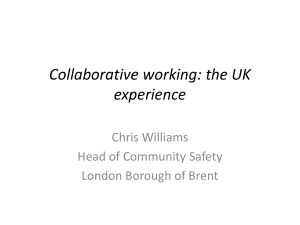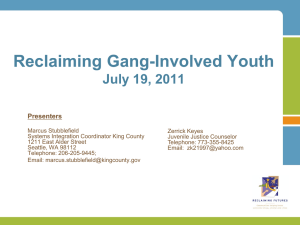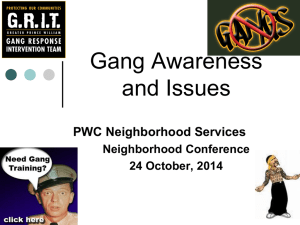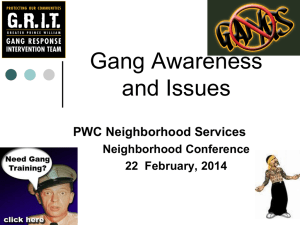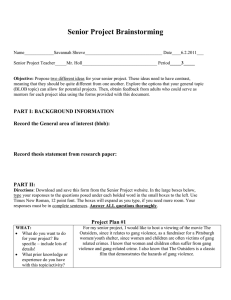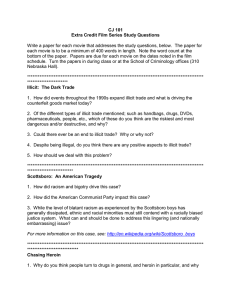Home Visitor Safety
advertisement
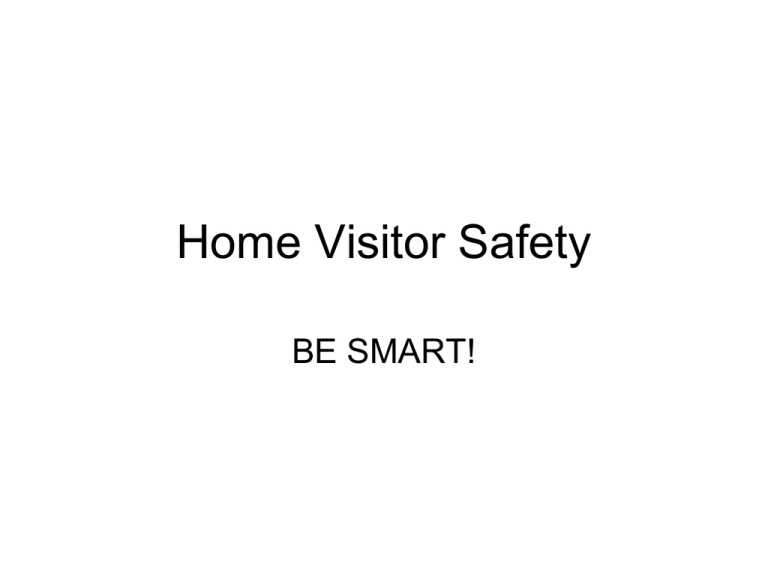
Home Visitor Safety BE SMART! Why should I be concerned? • In a 2004 report issued by the Occupational Safety and Health Administration on workplace violence, 48% of all non-fatal violence against all workers in the United States occurred in the fields of health care and social services • 50%-80% of public human service workers have experienced threats, damaged properties and physical attacks during their career Prior to the Visit • Find out as much as you can about the neighborhood and the family that you are going to visit prior to going • Alert someone about where you will be and what time to expect you back • Carry only what is necessary to complete the visit. Keep an ID with you, preferably without your home address • Wear a name badge, but avoid lanyard style; clip on is best • Bring a cell phone if possible • Think about the clothing you wear; your clothes should not impede your ability to move around safely and efficiently. Wear shoes with low heels or no heels. Arrival • Upon approaching the home, note exits and potential dangers (broken stairs, garbage, etc.) • Park in a well lit area, where the you can see the entry to the home, avoid the driveway if possible, if you must park there, back your car in • Keep alert; don’t use your cell phone or fumble for items as you approach the home The risk has gone up, why? • Affordable mental health services are difficult to find; those with mental health issues may not be able to afford care including medication • Gang related crime is increasing • Drugs/Drug use are more prevalent • Staff who are not adequately trained in recognizing danger signs and in responsive behaviors are new to home visiting • Guns, other weapons more prevalent • Personal stress levels increase as economic stability decreases Gangs? In Wisconsin? • A recent study by the Department of Justice indicated the presence of over 100 known gangs in N/E Wisconsin • Included counties of: Brown, Calumet, Winnebago, Outagamie, Fond du Lac, Manitowoc, Sheboygan • The study itself was criticized, however there was unanimous agreement that gang activity exists throughout N/E Wisconsin • Drug trafficking was the most common problem reported Concerns to Home Visitors in relation to Gangs • Gang Members tend to live in high crime areas • Drug use is prevalent among gang members • Gang retaliation can put home visitors at risk Drugs? In Wisconsin? Drug Paraphernalia Drug Paraphernalia Other Drug Concerns-Meth Labs Common Paraphernalia Some Common Meth Ingredients • Alcohol Gasoline additives/Rubbing Alcohol Ether (starting fluid) Benzene Paint thinner Freon Acetone Chloroform Camp stove fuel Anhydrous ammonia White gasoline Pheynl-2-Propane Phenylacetone Phenylpropanolamine Rock, table or Epsom salt Red Phosphorous Toluene (found in brake cleaner) Red Devil Lye Drain cleaner Muraitic acid Battery acid Lithium from batteries Sodium metal Ephedrine Cold tablets Diet aids Iodine Bronchodialators Energy boosters Iodine crystals Red Flags Related to Meth Labs • Strange odors resembling urine or the smell of acetone, ether or ammonia • Extra efforts to cover windows or to reinforce doors. • Trash not put out for collection. • Large amount of items, i.e. cooking dishes, coffee filters, bottles, that do not appear for regular household use. • Presence of unusual quantities of chemicals. • Vehicles loaded with laboratory materials or chemicals. Do not enter home with evidence of meth lab materials or chemicals on property. • If you enter and see evidence of a meth lab: • DO NOT USE YOUR CELL PHONE WHILE IN OR NEAR THE HOME • Discreetly but immediately leave • Drive to a safe location; contact local law enforcement If you are exposed: • Cover your car seats and floorboards with plastic covering. Clean hands with disinfectant wipes before touching the steering wheel. • Go to safe location to change clothes. Place dirty clothes in a plastic trash bag. Clean all exposed skin surfaces with soap & water. • Wash any items carried into the home with soap/water. • Don’t touch any surface until skin and items are clean. Exposure Signs Watery eyes Discharge from the eye Eye pain, including burning Skin irritation and redness Mild to severe burns Sneezing and coughing Congestion of the voice box Chest pain Nausea and vomiting Abdominal pain Diarrhea Moderate to severe headache Rapid heart rate Dark colored urine Fever Decrease in mental status Yellow jaundice Hallucinations Extreme irritability Severe neglect Difficult and labored breathing; shortness of breath Signs of Crack/Cocaine Use • • • • • Baking Soda Brillo pad remnants Matches Glass pipes Simple items like coke cans, spoons, light bulbs and straws found in odd places around the home could signal drug abuse Physical/Emotional Signs of Crack Use • physical signs of crack addiction include: dilated pupils, sweating, weight loss, frequent upper respiratory infections, fits of coughing, coughing up black mucous, muscle tremors, and severe headaches • Emotional signs include: dramatic mood changes, insomnia, loss of interest in usual activities Use a Buddy System (from Headstart) • — The family has a history of physical assaults or threats of violence, a criminal conviction involving the use of a weapon, or a disorderly persons offense; • — There are reports of any form of family violence (e.g., child abuse, spouse abuse), and the alleged abuser lives in or close to the home; • — A visit is to be made in a known drug-use location and/or a high-crime neighborhood; and • — The family has recently experienced the involuntary removal of a child from the home. Be prepared • Trust yourself • Go into the home with a pre-planned excuse to leave if it should be necessary • Don’t try to get in the middle or mediate an escalating situation, unless you are trained to do so and there for that purpose • Know the address of the home where you are, have it displayed in front of you if necessary. Make sure you are aware of what county you are in. • Report any dangerous activity to your supervisor immediately. Don’t enter the home when. . . • • • • • a. Questionable persons are present b. Parent/others are intoxicated c. Violence is in progress d. There is no quick escape e. Vicious animals are present Useful Items to have Available • • • • • • • • Cell phone and charger Emergency #s and contact information Small amount of money & change Plastic trash bags Disinfectant wipes and hand cleaner Latex gloves First aid kit Other items that you may need? Home Visitation Leadership Advisory Coalition Firearms If you see firearms, assume there could be danger to you or others in the home • If you know there are guns in the home but are not in view, ask where the guns are kept. • If there is an escalating situation where firearms could be used, leave and follow General Safety Guidelines. • If no danger, but firearms and ammunition are unlocked in the home: -Talk to parents about safe storage -Encourage parents to educate children about gun safety on a regular basis. Visitation Leadership Advisory Coalition Be Smart, Be Safe You are the key to your own personal safety!

